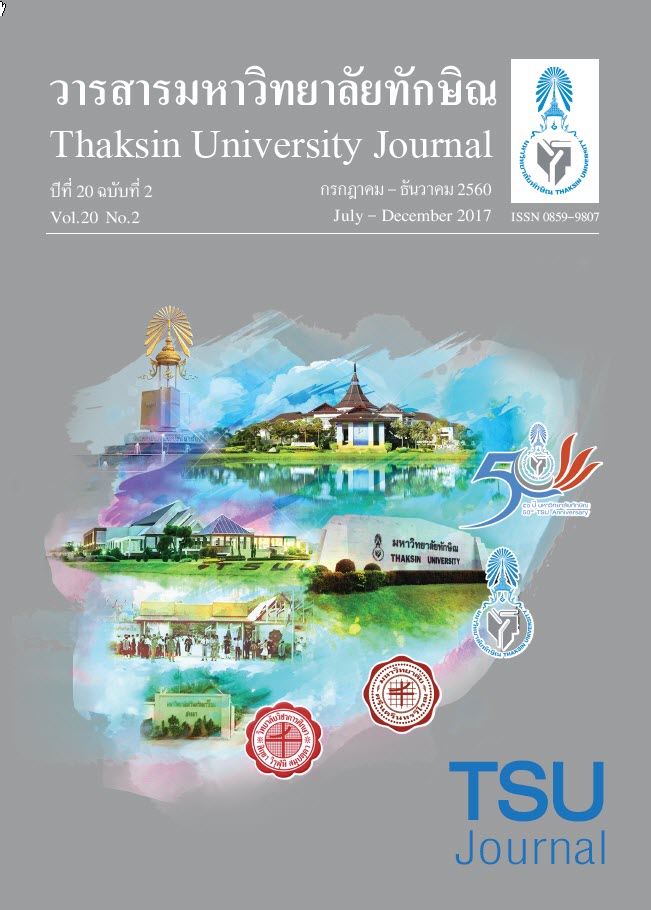Factors Related to Exercise Behavior among Students in Thaksin University, Phatthalung Campus Academic Year 2014
Main Article Content
Abstract
This study aimed to investigate factors related to exercise behavior among students in Thaksin University, Phatthalung Campus. Of these, 400 students were simply selected. The data was gathered by using questionnaire which Cronbach ’s alpha coefficient of attitude, perceived benefits, perceived barriers, motivations and practice towards exercise were 0.71, 0.81, 0.91, 0.83, and 0.91, respectively. Data was analyzed by using descriptive statistics and multiple logistics regression. The results found that gender, body mass index, lacking of exercise place, perceived benefit and practice towards exercise behavior were statistically related to exercise among students. Results suggested that the university administrator should promote and provide the appropriate place for physical exercise activities among students in Thaksin University, Phatthalung Campus.
Article Details
References
Journal of American College Health. 48(4), 175-180.
[2] Bureau of Policy and Strategy, Office of Permanent Secretary, Ministry of Public Health. (2011). Strategic
Framework, National Health Promotion and Disease Prevention 2011 – 2015 BE. Bangkok:
Samcharoen Panich (Bangkok) Co., Ltd.
[3] Khrisanapant W., Suttitum, T. and Tunkamnerdthai, O. (2011). “Lung volume and function in male adolescents
in Northeast, Thailand: students form Khon Kean Sports School in comparison with other schools in
Khon Kaen Province”, Srinagarind Medical Journal. 26(2), 98-105.
[4] Taylor, W.C., Blair, S.N., Cummings S.S., Wun C.C. and Malina R.M. (1999). “Childhood and adolescent
physical activity patterns and adult physical activity”, Medicine and Science in Sports and Exercise.
31(1), 118-123.
[5] Coulson, N.S., Eiser, C. and Eiser, J.R. (2007). “Diet, smoking and exercise: interrelationships between
adolescent health behaviors”, Child: Care, Health and Development. 23(3), 207-216.
[6] Bureau of Policy and Strategy, Office of Permanent Secretary, Ministry of Public Health. (2016). Health
Statistics 2015 BE. Bangkok: Samcharoen Panich (Bangkok) Co., Ltd.
[7] Tarokh, L., Saletin, J.M. and Carskadon, M.A. (2016). “Sleep in adolescence: Physiology, cognition and
mental health”, Neuroscience & Biobehavioral Reviews. 70,182-188.
[8] National Statistical Office, Ministry of Information and Communication Techonology. (2016). A Survey of
Exercise Behavior of Population 2007. Retrieved November 21, 2016, from http://service.nso.go.th/
nso/nsopublish/service/survey/excercise50.pdf.
[9] Rungruang, S., Pattanittum, P. and Kamsa-ard, S. (2006). Physical exercise of Khon Kaen University students.
Journal of Health Science. 15(2), 315-322.
[10] Woradet, S. and Chaimay, B. (2014). “Factors associated with exercise among students in Thaksin Uiversity,
Phatthalung Campus”, Journal of Public Health. 44(3), 288-299.
[11] Chaimay, B. (2013). “Sample size determination in descriptive study in public health”, Thaksin University
Journal. 16(2), 9-18.
[12] Chaimay, B. (2014). “Choosing statistics in data analysis for health science research”, Thaksin University
Journal. 17(1), 68-76.
[13] Pichainarong, N., Mahaweerawat, U., Chaelinfa, K., Khamkodsoon, J., Prarop, P., Kamsorn, W. and
Faonongdu, S. (2013). “Exercise, diet and supplementary food product to resuse weight among female
undergraduate students, Department of Performing Arts, Fauclty of Fine Arts and Applied Arts,
Mahasarakham University”, Journal of Science and Technology Mahasarakham University. 32(2),
213-219.
[14] Gatethai, S., Homsin, P. and Leelukkanaveera, Y. (2015). “Factors related to physical exercise among of
people with mobility impairment in Sapphaya District, Chai Nat Province”, Journal of Nursing and
Education. 8(1), 27-40.
[15] Ketkhaw, M., Suthiphan, W. and Lawan, N. (2011). “The state and need for exercise of junior secondary
school students in demonstration schools of Bangkok Metropolitan in academic year 2011”, SDU
Research Journal Sciences and Technology. 7(3), 103-113.
[16] Siripatt, A. (2012). “Exercise behaviors of exercise for health’s students”, Journal of Faculty Physical
Education. 15(Suppl.), 452-458.
[17] Kangsarigit, N., Khampolsiri, T. and Lasuka, D. (2009). “Effects of Fawn Jeng Mor Chor Exercise on level
of cholesterol among elders with dyslipidemia”, Nursing Journal. 36(4), 35–45.
[18] Boonphak, K. (2014). “Exercise behaviors of people in public parks in the Bangkok Metropolitan Area”,
Journal of Industrial Education. 13(2), 74-80.
[19] Hincharoen, Y. (2003). State and Needs of Exercise among Students at Nakhon Pathommm Rajabhat
University. Nakhon Pathom Rajabhat University.
[20] Kiadkangwan, T., Arpannatikul, M. and Malathum, P. (2012). “Factors predicting exercise behavior of
middle-age female nurses in the Northeast of Thailand”, Ramathibodi Nursing Journal. 18(1), 24-42.
[21] Sukanun, T., Subprasert, J., Jariyasilp, S. and Vongsala, A. (2014). “Factors affecting exercise behaviors of
the elderly people in Bansuan Municipality Chonburi”, The Public Health Journal of Burapha
University. 9(2), 66-75.
[22] Boonrin, P., Choeychom, S. and Nantsupawat, W. (2015). “Predictive factors on exercise behaviors of nursing
students”, Journal of Nursing and Health Care. 33(2), 176-186.
[23] Chamthong, T. (2014). “Exercise behaviors among members of health club at Nopphitam District, Nakhon
Sri Thamarat Province”, Southern Region Primary Health Care Journal. 28(2), 25–30.


